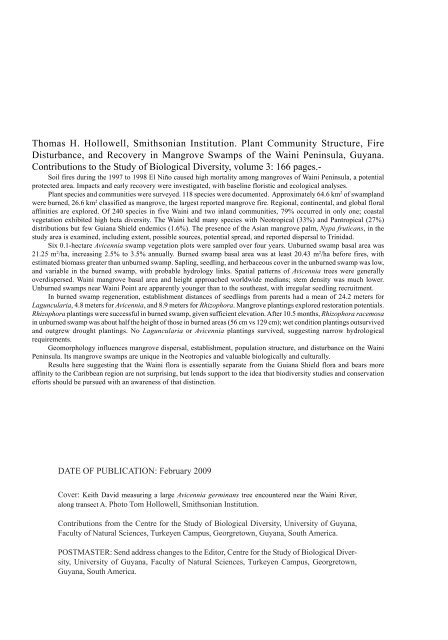Plant Community Structure, Fire Disturbance, and Recovery in ...
Plant Community Structure, Fire Disturbance, and Recovery in ...
Plant Community Structure, Fire Disturbance, and Recovery in ...
Create successful ePaper yourself
Turn your PDF publications into a flip-book with our unique Google optimized e-Paper software.
Thomas H. Hollowell, Smithsonian Institution. <strong>Plant</strong> <strong>Community</strong> <strong>Structure</strong>, <strong>Fire</strong><br />
<strong>Disturbance</strong>, <strong>and</strong> <strong>Recovery</strong> <strong>in</strong> Mangrove Swamps of the Wa<strong>in</strong>i Pen<strong>in</strong>sula, Guyana.<br />
Contributions to the Study of Biological Diversity, volume 3: 166 pages.-<br />
Soil fires dur<strong>in</strong>g the 1997 to 1998 El Niño caused high mortality among mangroves of Wa<strong>in</strong>i Pen<strong>in</strong>sula, a potential<br />
protected area. Impacts <strong>and</strong> early recovery were <strong>in</strong>vestigated, with basel<strong>in</strong>e floristic <strong>and</strong> ecological analyses.<br />
<strong>Plant</strong> species <strong>and</strong> communities were surveyed. 118 species were documented. Approximately 64.6 km 2 of swampl<strong>and</strong><br />
were burned, 26.6 km 2 classified as mangrove, the largest reported mangrove fire. Regional, cont<strong>in</strong>ental, <strong>and</strong> global floral<br />
aff<strong>in</strong>ities are explored. Of 240 species <strong>in</strong> five Wa<strong>in</strong>i <strong>and</strong> two <strong>in</strong>l<strong>and</strong> communities, 79% occurred <strong>in</strong> only one; coastal<br />
vegetation exhibited high beta diversity. The Wa<strong>in</strong>i held many species with Neotropical (33%) <strong>and</strong> Pantropical (27%)<br />
distributions but few Guiana Shield endemics (1.6%). The presence of the Asian mangrove palm, Nypa fruticans, <strong>in</strong> the<br />
study area is exam<strong>in</strong>ed, <strong>in</strong>clud<strong>in</strong>g extent, possible sources, potential spread, <strong>and</strong> reported dispersal to Tr<strong>in</strong>idad.<br />
Six 0.1-hectare Avicennia swamp vegetation plots were sampled over four years. Unburned swamp basal area was<br />
21.25 m 2 /ha, <strong>in</strong>creas<strong>in</strong>g 2.5% to 3.5% annually. Burned swamp basal area was at least 20.43 m 2 /ha before fires, with<br />
estimated biomass greater than unburned swamp. Sapl<strong>in</strong>g, seedl<strong>in</strong>g, <strong>and</strong> herbaceous cover <strong>in</strong> the unburned swamp was low,<br />
<strong>and</strong> variable <strong>in</strong> the burned swamp, with probable hydrology l<strong>in</strong>ks. Spatial patterns of Avicennia trees were generally<br />
overdispersed. Wa<strong>in</strong>i mangrove basal area <strong>and</strong> height approached worldwide medians; stem density was much lower.<br />
Unburned swamps near Wa<strong>in</strong>i Po<strong>in</strong>t are apparently younger than to the southeast, with irregular seedl<strong>in</strong>g recruitment.<br />
In burned swamp regeneration, establishment distances of seedl<strong>in</strong>gs from parents had a mean of 24.2 meters for<br />
Laguncularia, 4.8 meters for Avicennia, <strong>and</strong> 8.9 meters for Rhizophora. Mangrove plant<strong>in</strong>gs explored restoration potentials.<br />
Rhizophora plant<strong>in</strong>gs were successful <strong>in</strong> burned swamp, given sufficient elevation. After 10.5 months, Rhizophora racemosa<br />
<strong>in</strong> unburned swamp was about half the height of those <strong>in</strong> burned areas (56 cm vs 129 cm); wet condition plant<strong>in</strong>gs outsurvived<br />
<strong>and</strong> outgrew drought plant<strong>in</strong>gs. No Laguncularia or Avicennia plant<strong>in</strong>gs survived, suggest<strong>in</strong>g narrow hydrological<br />
requirements.<br />
Geomorphology <strong>in</strong>fluences mangrove dispersal, establishment, population structure, <strong>and</strong> disturbance on the Wa<strong>in</strong>i<br />
Pen<strong>in</strong>sula. Its mangrove swamps are unique <strong>in</strong> the Neotropics <strong>and</strong> valuable biologically <strong>and</strong> culturally.<br />
Results here suggest<strong>in</strong>g that the Wa<strong>in</strong>i flora is essentially separate from the Guiana Shield flora <strong>and</strong> bears more<br />
aff<strong>in</strong>ity to the Caribbean region are not surpris<strong>in</strong>g, but lends support to the idea that biodiversity studies <strong>and</strong> conservation<br />
efforts should be pursued with an awareness of that dist<strong>in</strong>ction.<br />
DATE OF PUBLICATION: February 2009<br />
Cover: Keith David measur<strong>in</strong>g a large Avicennia germ<strong>in</strong>ans tree encountered near the Wa<strong>in</strong>i River,<br />
along transect A. Photo Tom Hollowell, Smithsonian Institution.<br />
Contributions from the Centre for the Study of Biological Diversity, University of Guyana,<br />
Faculty of Natural Sciences, Turkeyen Campus, Georgretown, Guyana, South America.<br />
POSTMASTER: Send address changes to the Editor, Centre for the Study of Biological Diversity,<br />
University of Guyana, Faculty of Natural Sciences, Turkeyen Campus, Georgretown,<br />
Guyana, South America.
















